Nonseasonal Variations in Near-Inertial Kinetic Energy Observed Far below the Surface Mixed Layer in the Southwestern East Sea (Japan Sea)
Abstract
1. Introduction
2. Data and Methods
2.1. Data
2.2. Methods
3. Results
3.1. Intraseasonal, Interannual, and Decadal Variations of Near-Inertial Kinetic Energy below and within the Surface Mixed Layer
3.2. Composite Mean of Near-Inertial Kinetic Energy at 400 m Dependent on Mesoscale Condition
4. Discussion
4.1. Comparison to Known Characteristics of Near-Inertial Internal Waves (NIWs)
4.2. Effects of Surface Wind Forcing on Near-Inertial Energy within and below the Mixed Layer
4.3. Effects of Mesoscale Flow Fields on Near-Inertial Energy Far below the Mixed Layer
5. Concluding Remarks
Author Contributions
Funding
Institutional Review Board Statement
Informed Consent Statement
Data Availability Statement
Acknowledgments
Conflicts of Interest
References
- Garrett, C. What is the “near-inertial” band and why is it different from the rest of the internal wave spectrum? J. Phys. Oceanogr. 2001, 31, 962–971. [Google Scholar] [CrossRef]
- Alford, M.H.; MacKinnon, J.A.; Simmons, H.L.; Nash, J.D. Near-inertial internal gravity waves in the ocean. Annu. Rev. Mar. Sci. 2016, 8, 95–123. [Google Scholar] [CrossRef]
- MacKinnon, J.A.; Alford, M.H.; Ansong, J.K.; Arbic, B.K.; Barna, A.; Briegleb, B.P.; Bryan, F.O.; Buijsman, M.C.; Chassignet, E.P.; Danabasoglu, G.; et al. Climate process team on internal wave-driven ocean mixing. Bull. Am. Meteorol. Soc. 2017, 98, 2429–2454. [Google Scholar] [CrossRef] [PubMed]
- Whalen, C.B.; MacKinnon, J.A.; Talley, L.D. Large-scale impacts of the mesoscale environment on mixing from wind-driven internal waves. Nat. Geosci. 2018, 11, 842–847. [Google Scholar] [CrossRef]
- Egbert, G.D.; Ray, R.D. Significant dissipation of tidal energy in the deep ocean inferred from satellite altimeter data. Nature 2000, 405, 775–778. [Google Scholar] [CrossRef]
- Nycander, J. Generation of internal waves in the deep ocean by tides. J. Geophys. Res. 2005, 110, C10028. [Google Scholar] [CrossRef]
- Jiang, J.; Lu, Y.; Perrie, W. Estimating the energy flux from the wind to ocean inertial motions: The sensitivity to surface wind fields. Geophys. Res. Lett. 2005, 32, L15610. [Google Scholar] [CrossRef]
- Garrett, C.J.R.; Munk, W. Internal waves in the ocean: A progress report. Annu. Rev. Fluid Mech. 1979, 11, 339–369. [Google Scholar] [CrossRef]
- Munk, W.; Wunsch, C. Abyssal recipes II: Energetics of tidal and wind mixing. Deep-Sea Res. Part I Oceanogr. Res. Pap. 1998, 45, 1977–2010. [Google Scholar] [CrossRef]
- Müller, P.; Briscoe, M. Diapycnal mixing and internal waves. Oceanography 2000, 13, 98–103. [Google Scholar] [CrossRef][Green Version]
- Alford, M.H. Redistribution of energy available for ocean mixing. Nature 2003, 428, 159–162. [Google Scholar] [CrossRef]
- Ferrari, R.; Wunsch, C. Ocean circulation kinetic energy: Reservoirs, sources, and sinks. Annu. Rev. Fluid Mech. 2009, 41, 253–282. [Google Scholar] [CrossRef]
- Whalen, C.B.; de Lavergne, C.; Naveira Garabato, A.C.; Klymak, J.M.; MacKinnon, J.A.; Sheen, K.L. Internal wave-driven mixing: Governing processes and consequences for climate. Nat. Rev. 2020, 1, 606–621. [Google Scholar] [CrossRef]
- Nikurashin, M.; Ferrari, R. Overturning circulation driven by breaking internal waves in the deep ocean. Geophys. Res. Lett. 2013, 40, 3133–3137. [Google Scholar] [CrossRef]
- Vic, C.; Garabato, A.C.N.; Green, J.M.; Waterhouse, A.F.; Zhao, Z.; Melet, A.; De Lavergne, C.; Buijsman, M.C.; Stephenson, G.R. Deep-ocean mixing driven by small-scale internal tides. Nat. Commun. 2019, 10, 2099. [Google Scholar] [CrossRef]
- Blaker, A.T.; Hirschi, J.J.M.; Sinha, B.; de Cuevas, B.; Alderson, S.; Coward, A.; Madec, G. Large near-inertial oscillations of the Atlantic meridional overturning circulation. Ocean Model. 2012, 42, 50–56. [Google Scholar] [CrossRef]
- Xiao, J.; Xie, Q.; Wang, D.; Yang, L.; Shu, Y.; Liu, C.; Chen, J.; Yao, J.; Chen, G. On the near-inertial variations of meridional overturning circulation in the South China Sea. Ocean Sci. 2016, 12, 335–344. [Google Scholar] [CrossRef]
- Lucas, A.J.; Franks, P.J.S.; Dupont, C.L. Horizontal internal-tide fluxes support elevated phytoplankton productivity over the inner continental shelf. Limnol. Oceanog. 2011, 1, 56–74. [Google Scholar] [CrossRef]
- Pan, X.; Wong, G.T.F.; Shiah, F.-K.; Ho, T.-Y. Enhancement of biological productivity by internal waves: Observations in the summertime in the northern South China Sea. J. Oceanogr. 2012, 68, 427–437. [Google Scholar] [CrossRef]
- Muacho, S.; da Silva, J.C.B.; Brotas, V.; Oliveira, P.B. Effect of internal waves on near-surface chlorophyll concentration and primary production in the Nazaré Canyon (west of the Iberian Peninsula). Deep Sea Res. Part I Oceanogr. Res. Pap. 2013, 81, 89–96. [Google Scholar] [CrossRef]
- Villamaña, M.; Mouriño-Carballido, B.; Marañón, E.; Cermeño, P.; Chouciño, P.; da Silva, J.C.B.; Díaz, P.A.; Fernández-Castro, B.; Gilcoto, M.; Graña, R.; et al. Role of internal waves on mixing, nutrient supply and phytoplankton community structure during spring and neap tides in the upwelling ecosystem of Ría de Vigo (NW Iberian Peninsula). Limnol. Oceanogr. 2017, 62, 1014–1030. [Google Scholar] [CrossRef]
- Li, D.; Chou, W.C.; Shih, Y.Y.; Chen, G.Y.; Chang, Y.; Chow, C.H.; Lin, T.Y.; Hung, C.C. Elevated particulate organic carbon export flux induced by internal waves in the oligotrophic northern South China Sea. Sci. Rep. 2018, 8, 2042. [Google Scholar] [CrossRef] [PubMed]
- Song, H.; Marshall, J.; Campin, J.M.; McGillicuddy, D.J. Impact of near-inertial waves on vertical mixing and air-sea CO2 fluxes in the Southern Ocean. J. Geophys. Res. Oceans 2019, 124, 4605–4617. [Google Scholar] [CrossRef]
- Kunze, E. Near-Inertial Wave Propagation in geostrophic shear. J. Phys. Oceanogr. 1985, 15, 544–565. [Google Scholar] [CrossRef]
- D’asaro, E.A. Upper-ocean inertial currents forced by a strong storm. Part III: Interaction of inertial currents and mesoscale eddies. J. Phys. Oceanogr. 1995, 25, 2953–2958. [Google Scholar] [CrossRef]
- Whitt, D.B.; Thomas, L.N. Resonant generation and energetics of wind-forced near-inertial motions in a geostrophic flow. J. Phys. Oceanogr. 2015, 45, 181–208. [Google Scholar] [CrossRef]
- Jing, Z.; Wu, L.; Ma, X. Energy exchange between the mesoscale oceanic eddies and wind-forced near-inertial oscillations. J. Phys. Oceanogr. 2017, 47, 721–733. [Google Scholar] [CrossRef]
- Lee, D.-K.; Niiler, P.P. The inertial chimney: The near-inertial energy drainage from the ocean surface to the deep layer. J. Geophys. Res. Oceans 1998, 103, 7579–7591. [Google Scholar] [CrossRef]
- Danioux, E.; Klein, P.; Rivière, P. Propagation of wind energy into the deep ocean through a fully turbulent mesoscale eddy field. J. Phys. Oceanogr. 2008, 38, 2224–2241. [Google Scholar] [CrossRef]
- BÜhler, O.; McIntyre, M.E. Wave capture and wave–vortex duality. J. Fluid Mech. 2005, 534, 67–95. [Google Scholar] [CrossRef]
- Polzin, K.L. Mesoscale eddy–internal wave coupling. Part I: Symmetry, wave Capture, and results from the mid-ocean dynamics experiment. J. Phys. Oceanogr. 2008, 38, 2556–2574. [Google Scholar] [CrossRef][Green Version]
- Polzin, K.L. Mesoscale eddy–internal wave coupling. Part II: Energetics and results from PolyMode. J. Phys. Oceanogr. 2010, 40, 789–801. [Google Scholar] [CrossRef]
- Jing, Z.; Chang, P.; DiMarco, S.F.; Wu, L. Observed energy exchange between low-frequency flows and internal waves in the Gulf of Mexico. J. Phys. Oceanogr. 2018, 48, 995–1008. [Google Scholar] [CrossRef]
- Chang, K.I.; Teague, W.J.; Lyu, S.J.; Perkins, H.T.; Lee, D.K.; Watts, D.R.; Kim, Y.B.; Mitchell, D.A.; Lee, C.M.; Kim, K. Circulation and currents in the southwestern East/Japan Sea: Overview and review. Prog. Oceanogr. 2004, 61, 105–156. [Google Scholar] [CrossRef]
- Shin, H.-R.; Shin, C.-W.; Kim, C.; Byun, S.-K.; Hwang, S.-C. Movement and structural variation of warm eddy WE92 for three years in the Western East/Japan Sea. Deep Sea Res. Part II Top. Stud. Oceanogr. 2005, 52, 1742–1762. [Google Scholar] [CrossRef]
- Mori, K.; Matsuno, T.; Senjyu, T. Seasonal/spatial variations of the near-inertial oscillations in the deep water of the Japan Sea. J. Oceanogr. 2005, 61, 761–773. [Google Scholar] [CrossRef]
- Jeon, C.; Park, J.H.; Park, Y.G. Temporal and spatial variability of near-inertial waves in the East/Japan Sea from a high-resolution wind-forced ocean model. J. Geophys. Res. Oceans. 2019, 124, 6015–6029. [Google Scholar] [CrossRef]
- Park, J.-H.; Watts, D.R. Near-inertial oscillations interacting with mesoscale circulation in the southwestern Japan/East Sea. Geophys. Res. Lett. 2005, 32, L10611. [Google Scholar] [CrossRef]
- Byun, S.-S.; Park, J.J.; Chang, K.-I.; Schmitt, R.W. Observation of near-inertial wave reflections within the thermostad layer of an anticyclonic mesoscale eddy. Geophys. Res. Lett. 2010, 37, L01606. [Google Scholar] [CrossRef]
- Noh, S.; Nam, S. Observations of enhanced internal waves in an area of strong mesoscale variability in the southwestern East Sea (Japan Sea). Sci. Rep. 2020, 10, 9068. [Google Scholar] [CrossRef] [PubMed]
- Lee, H.; Nam, S. EC1, Long and Continuous Mooring Time Series from 1996 to 2020; SEANOE: Paris, France, 2021. [Google Scholar] [CrossRef]
- Good, S.A.; Martin, M.J.; Rayner, N.A. EN4: Quality controlled ocean temperature and salinity profiles and monthly objective analyses with uncertainty estimates. J. Geophys. Res. Oceans 2013, 118, 6704–6716. [Google Scholar] [CrossRef]
- Chelton, D.B.; DeSzoeke, R.A.; Schlax, M.G.; El Naggar, K.; Siwertz, N. Geographical variability of the first baroclinic Rossby radius of deformation. J. Phys. Oceanogr. 1998, 28, 433–460. [Google Scholar] [CrossRef]
- Lim, S.; Jang, C.J.; Oh, I.S.; Park, J. Climatology of the mixed layer depth in the East/Japan Sea. J. Mar. Syst. 2012, 96–97, 1–14. [Google Scholar] [CrossRef]
- Mulet, S.; Rio, M.H.; Etienne, H.; Artana, C.; Cancet, M.; Dibarboure, G.; Feng, H.; Husson, R.; Picot, N.; Provost, C.; et al. The new CNES-CLS18 global mean dynamic topography. Ocean Sci. 2021, 17, 789–808. [Google Scholar] [CrossRef]
- U.S. Integrated Ocean Observing System. Manual for Real-Time Quality Control of In-Situ Current Observations; Version 2.1; U.S. Department of Commerce, National Oceanic and Atmospheric Administration, National Ocean Service, Integrated Ocean Observing System: Silver Spring, MD, USA, 2019. [CrossRef]
- Min, Y.; Jeong, J.-Y.; Jang, C.J.; Lee, J.; Jeong, J.; Min, I.-K.; Shim, J.-S.; Kim, Y.S. Quality control of observed temperature time series from the Korea Ocean Research Stations: Preliminary application of ocean observation initiative’s approach and its limitation. Ocean Polar Res. 2020, 42, 195–210. [Google Scholar] [CrossRef]
- Leaman, K.D.; Sanford, T.B. Vertical energy propagation of inertial waves: A vector spectral analysis of velocity profiles. J. Geophys. Res. 1975, 80, 1975–1978. [Google Scholar] [CrossRef]
- Lee, K.; Nam, S.; Kim, Y.-G. Statistical characteristics of east sea mesoscale eddies detected, tracked, and grouped using satellite altimeter data from 1993 to 2017. Sea 2019, 24, 267–281. [Google Scholar] [CrossRef]
- Torrence, C.; Compo, G.P. A practical guide to wavelet analysis. Bull. Am. Meteorol. Soc. 1998, 79, 61–78. [Google Scholar] [CrossRef]
- de Boyer Montégut, C. Mixed layer depth over the global ocean: An examination of profile data and a profile-based climatology. J. Geophys. Res. 2004, 109, C12003. [Google Scholar] [CrossRef]
- Pollard, R.T.; Millard Jr, R. Comparison between observed and simulated wind-generated inertial oscillations. Deep-Sea Res. Oceanogr. Abstr. 1970, 17, 813–816. [Google Scholar] [CrossRef]
- D’Asaro, E.A. The energy flux from the wind to near-inertial motions in the surface mixed layer. J. Phys. Oceanogr. 1985, 15, 1043–1059. [Google Scholar] [CrossRef]
- Park, J.J.; Kim, K.; Schmitt, R.W. Global distribution of the decay timescale of mixed layer inertial motions observed by satellite-tracked drifters. J. Geophys. Res. Oceans 2009, 114, C11010. [Google Scholar] [CrossRef]
- Kawaguchi, Y.; Wagawa, T.; Igeta, Y. Near-inertial internal waves and multiple-inertial oscillations trapped by negative vorticity anomaly in the central Sea of Japan. Prog. Oceanogr. 2020, 181, 102240. [Google Scholar] [CrossRef]
- Chiswell, S.M. Deep equatorward propagation of inertial oscillations. Geophys. Res. Lett. 2003, 30, 1533. [Google Scholar] [CrossRef]
- Okubo, A. Horizontal dispersion of floatable particles in the vicinity of velocity singularities such as convergences. Deep-Sea Res. Oceanogr. Abstr. 1970, 17, 445–454. [Google Scholar] [CrossRef]
- Chavanne, C.P.; Firing, E.; Ascani, F. Inertial oscillations in geostrophic flow: Is the inertial frequency shifted by ζ/2 or by ζ? J. Phys. Oceanogr. 2012, 42, 884–888. [Google Scholar] [CrossRef]
- Shcherbina, A.Y.; Talley, L.D.; Firing, E.; Hacker, P. Near-surface frontal zone trapping and deep upward propagation of internal wave energy in the Japan/East Sea. J. Phys. Oceanogr. 2003, 33, 900–912. [Google Scholar] [CrossRef][Green Version]
- Song, H.; Jeon, C.; Chae, J.Y.; Lee, E.J.; Lee, K.N.; Takayama, K.; Choi, Y.; Park, J.H. Effects of typhoon and mesoscale eddy on generation and distribution of near-inertial wave energy in the East Sea. Sea 2020, 25, 55–66. [Google Scholar] [CrossRef]
- Nam, S.; Kim, D.; Kim, H.R.; Kim, Y.G. Typhoon-induced, highly nonlinear internal solitary waves off the east coast of Korea. Geophys. Res. Lett. 2007, 34, L01607. [Google Scholar] [CrossRef]
- Furuichi, N.; Hibiya, T.; Niwa, Y. Model-predicted distribution of wind-induced internal wave energy in the world’s oceans. J. Geophys. Res. Oceans 2008, 113, C09034. [Google Scholar] [CrossRef]
- Zhai, X.; Greatbatch, R.J.; Eden, C.; Hibiya, T. On the loss of wind-induced near-inertial energy to turbulent mixing in the upper ocean. J. Phys. Oceanogr. 2009, 39, 3040–3045. [Google Scholar] [CrossRef]
- Jin, H.; Park, Y.G.; Pak, G.; Kim, Y.H. On the persistence of warm eddies in the East Sea. Sea 2019, 24, 318–331. [Google Scholar] [CrossRef]
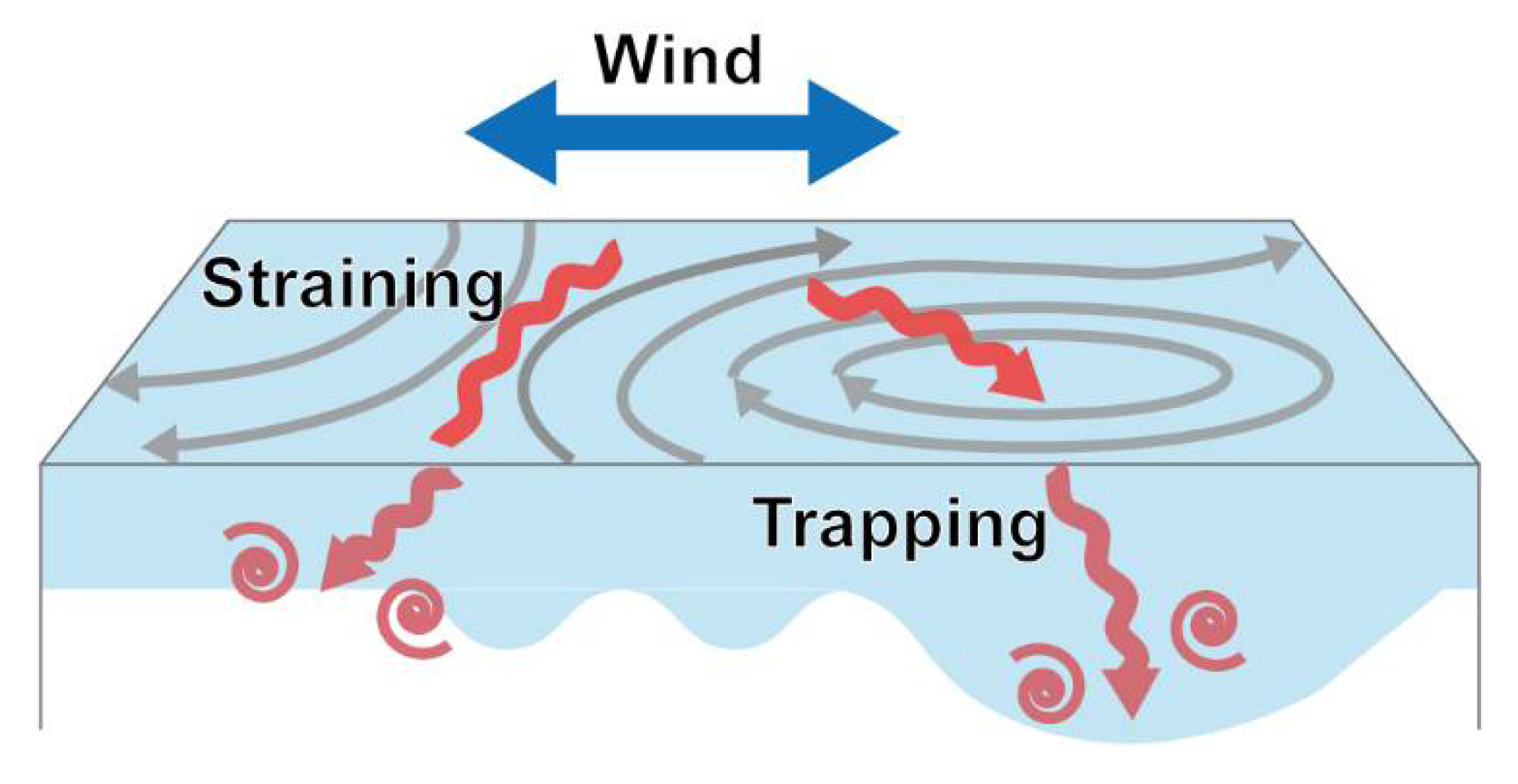

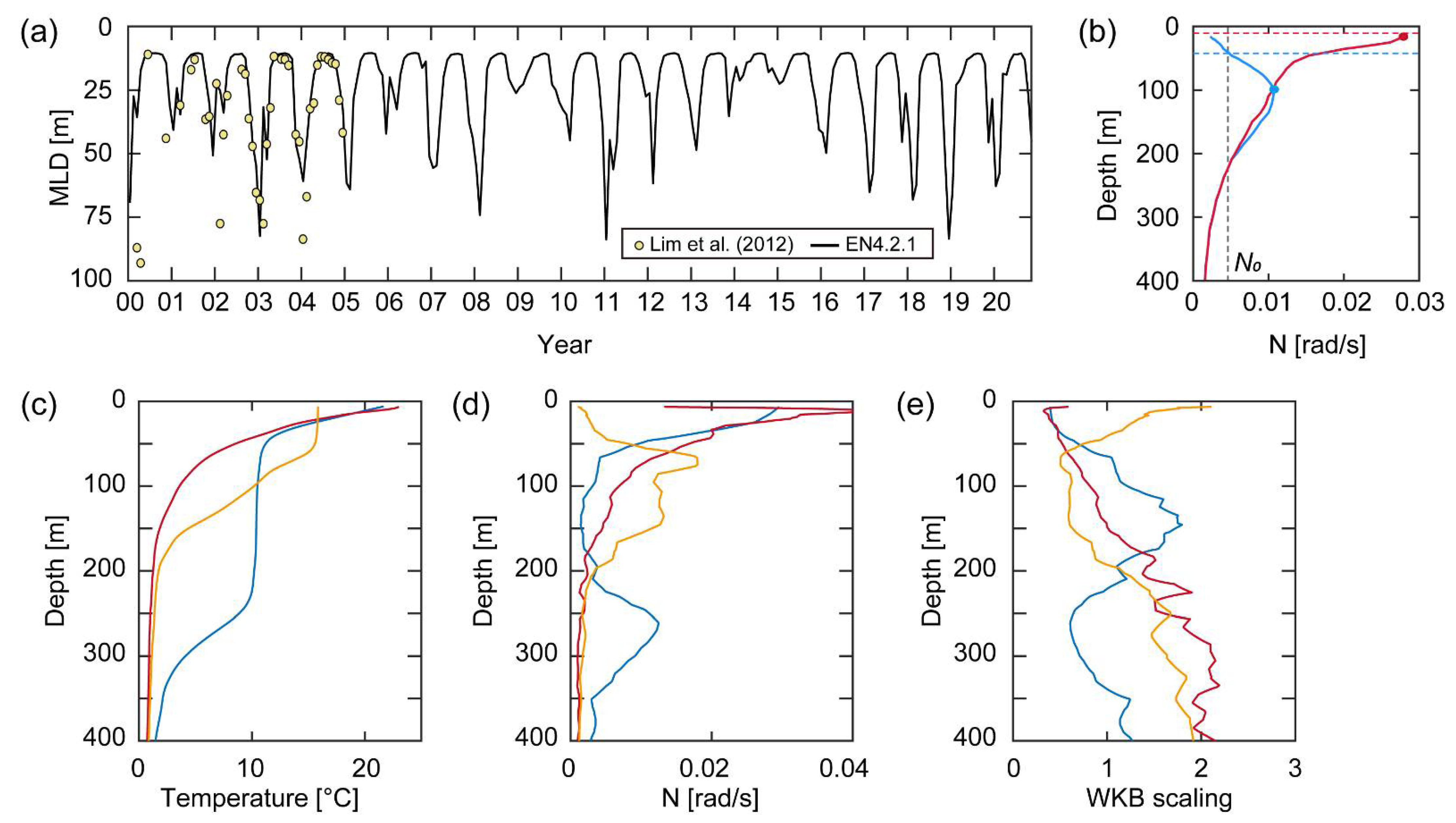
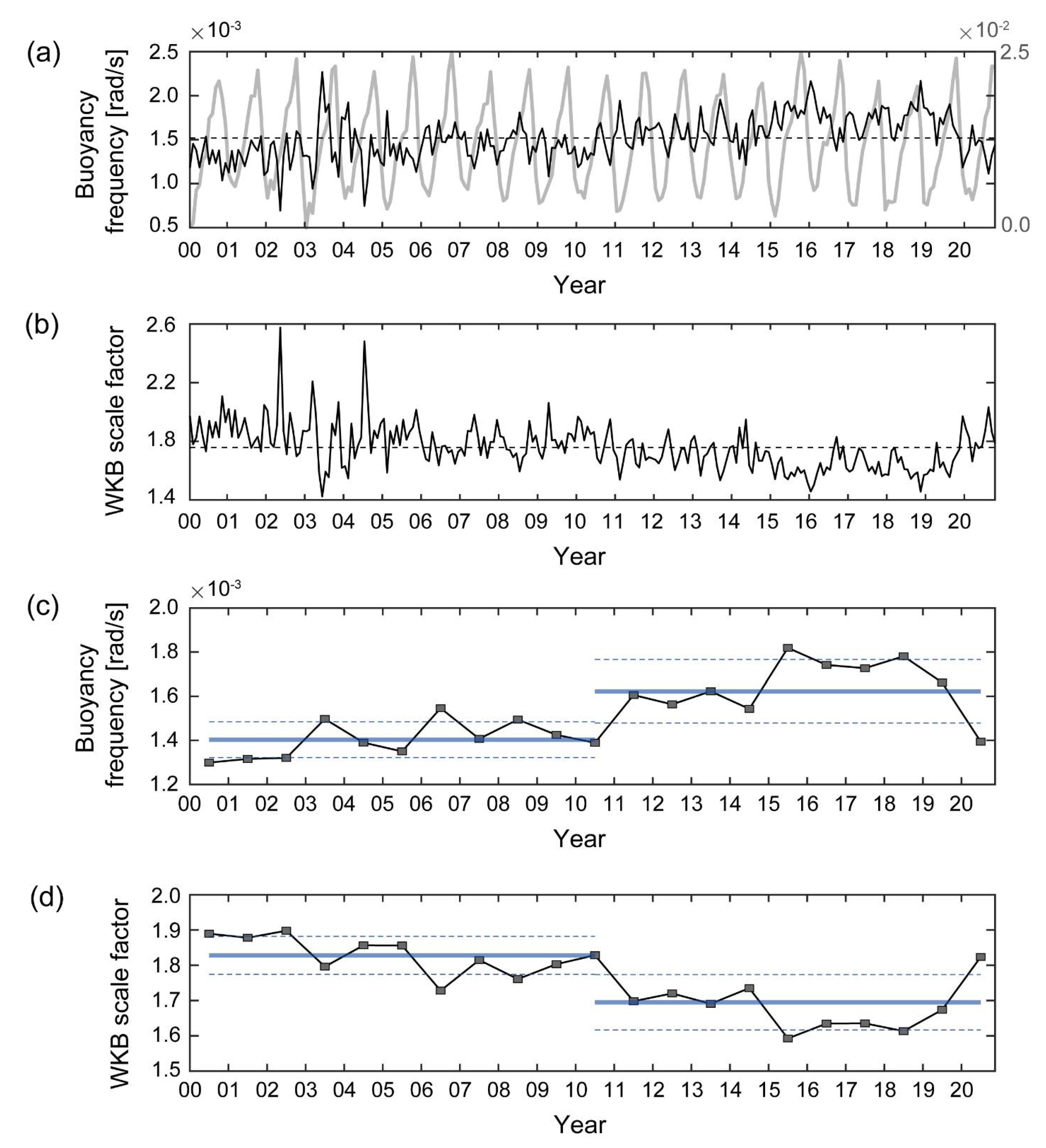
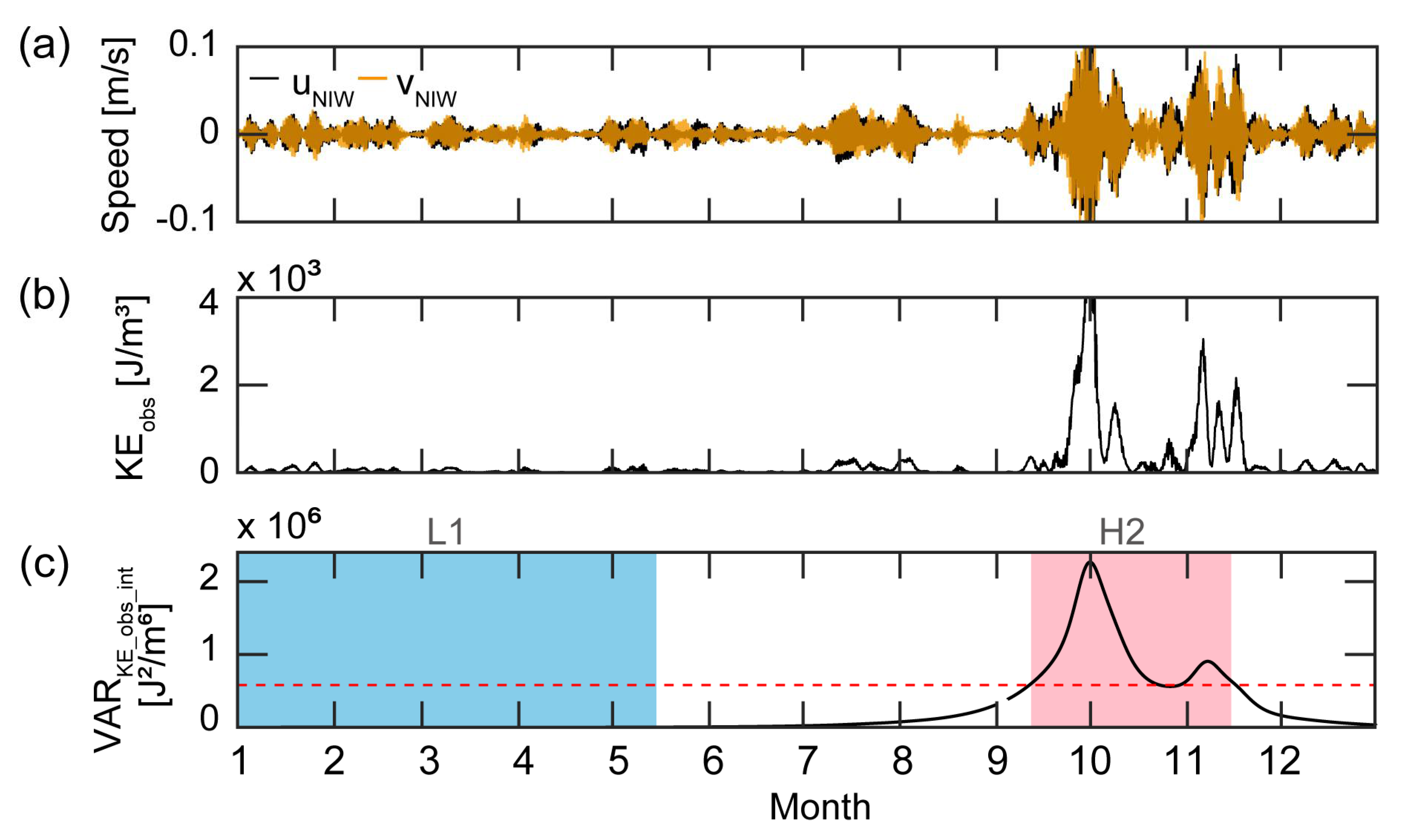

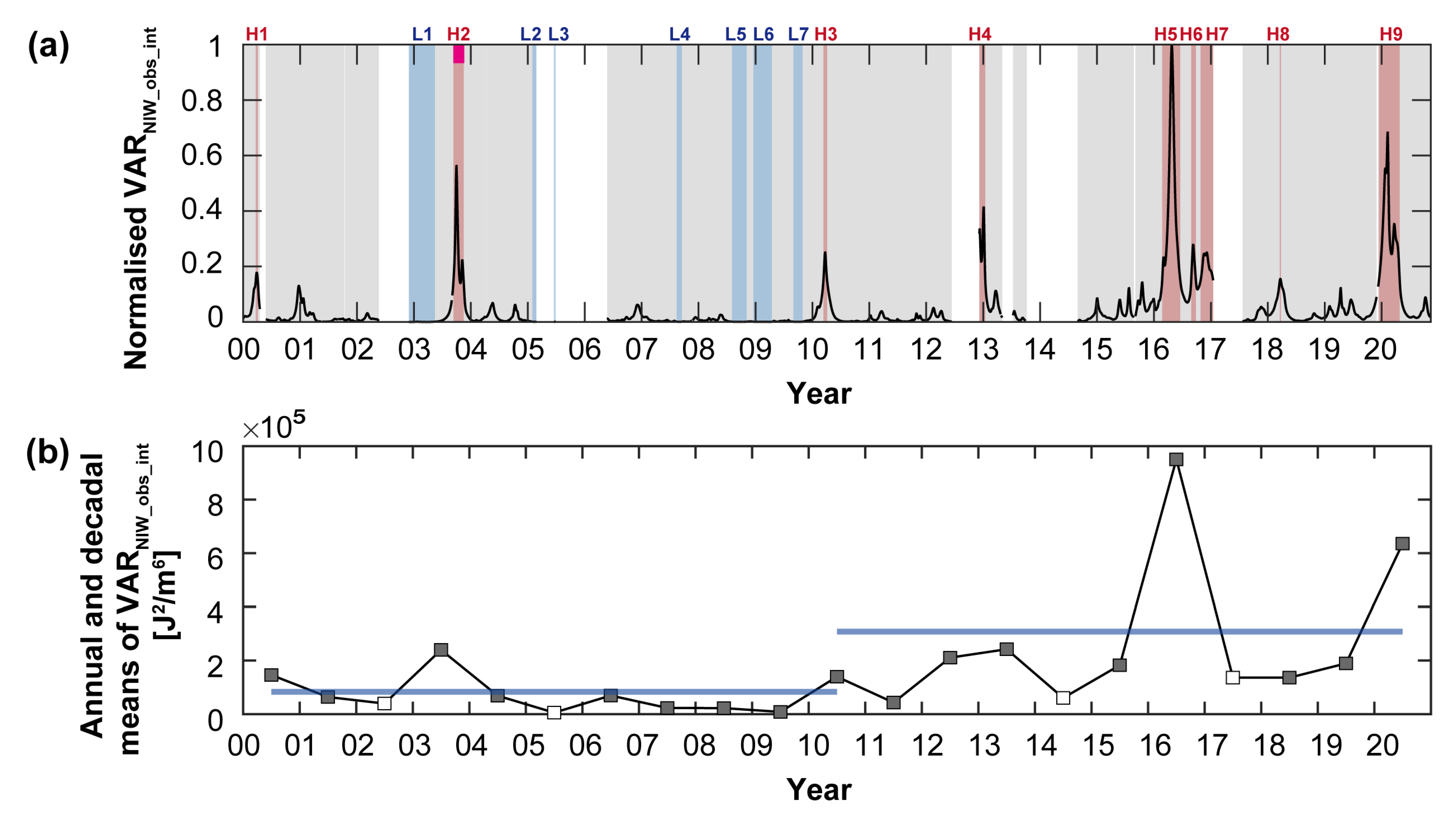
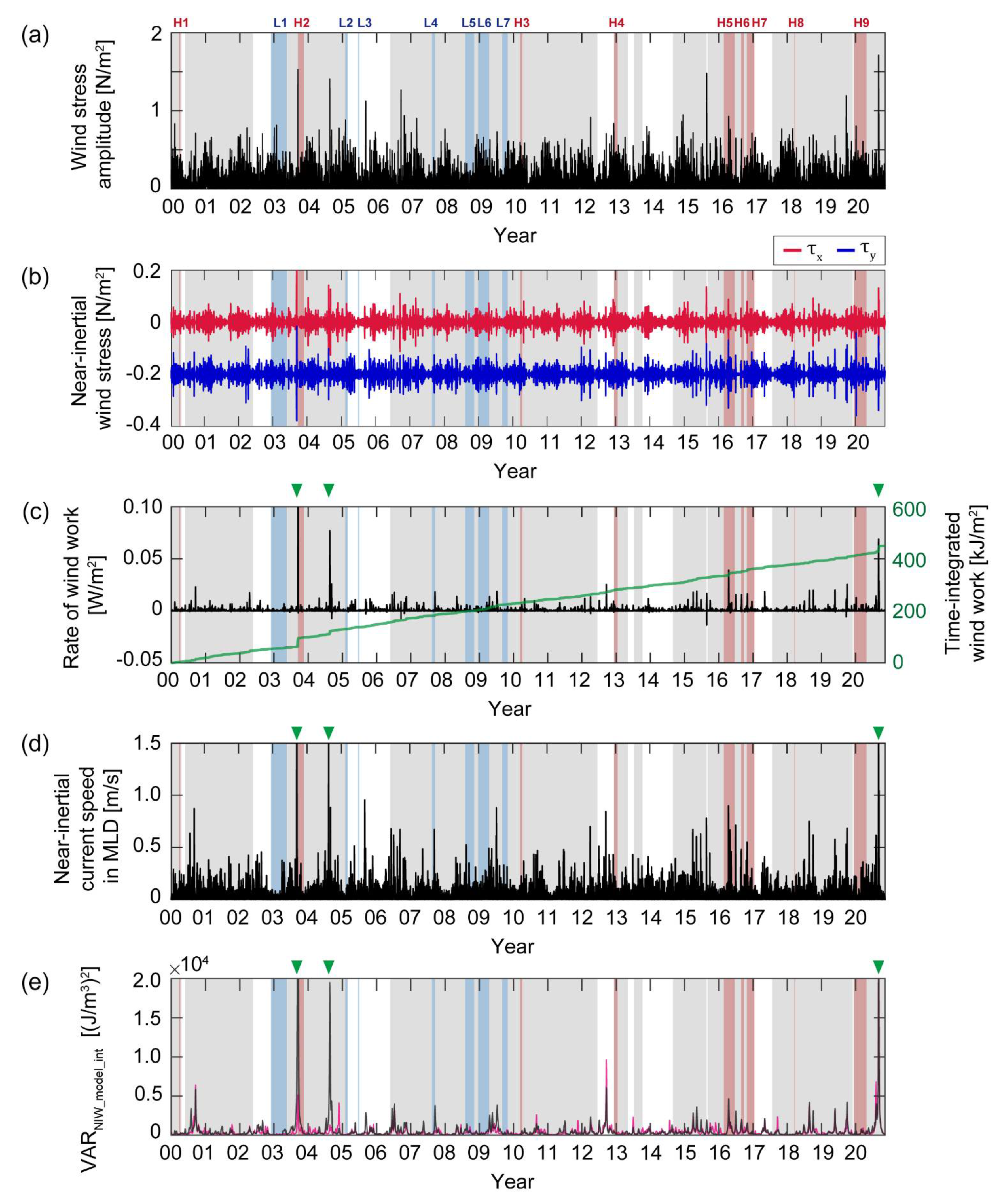
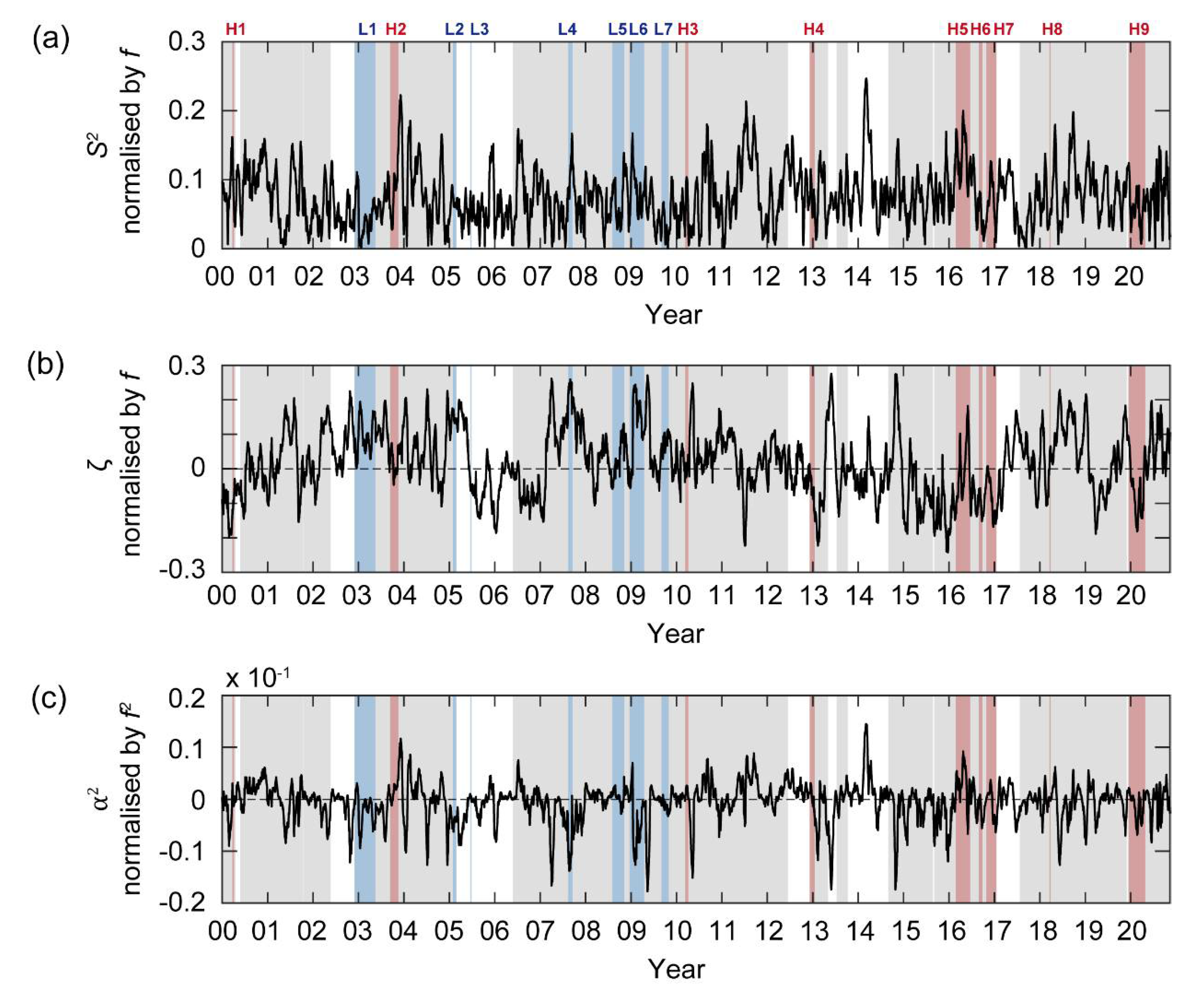
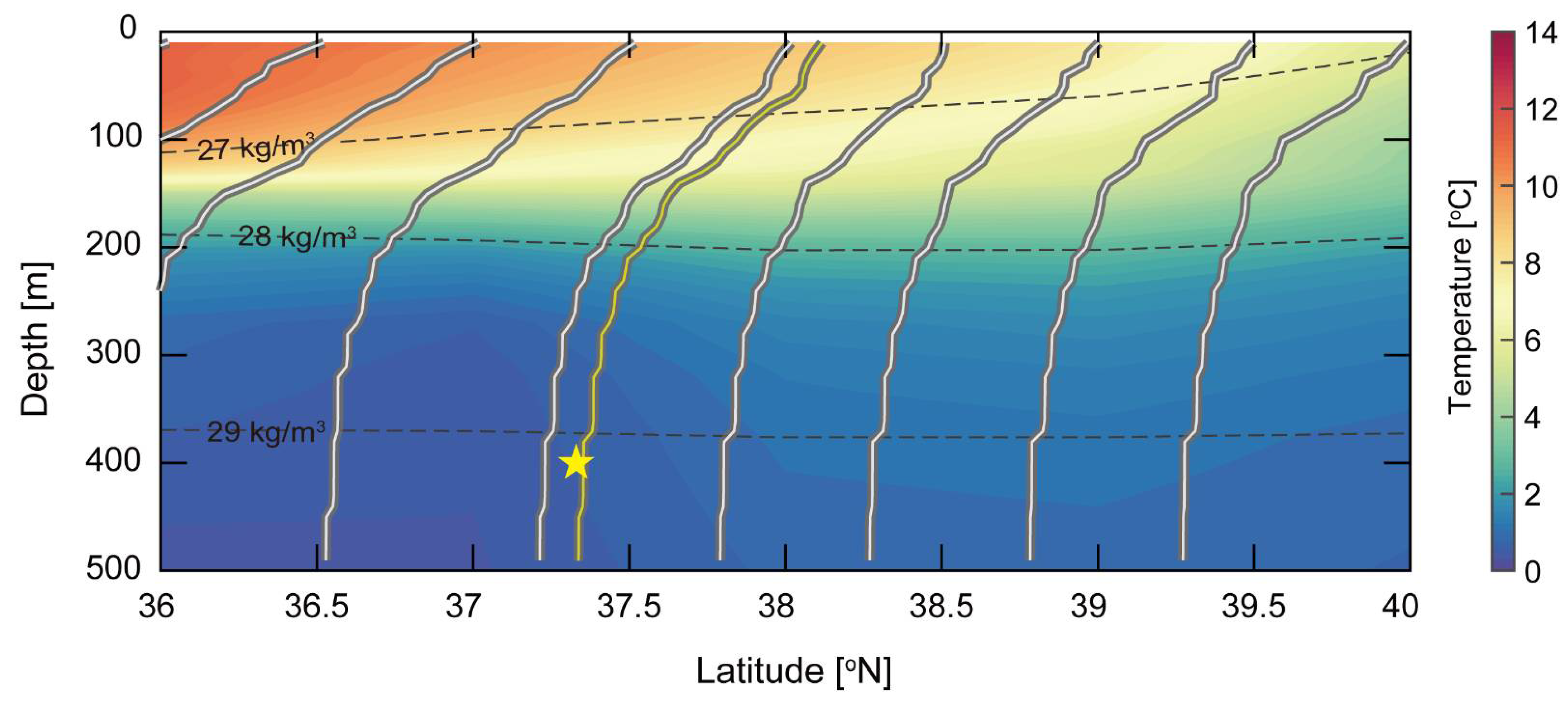

| Period | (10−3 W/m2) | (f/s) | (f/s) | (×10−12/s2) | |
|---|---|---|---|---|---|
| H1 | 22 March–4 April 2000 | 0.39 (0.34) | −0.11 (0.02) | 0.11 (0.03) | 3.10 (9.89) |
| H2 | 12 September–15 November 2003 | 5.23 (23.52) | 0.01 (0.04) | 0.08 (0.03) | 10.39 (10.92) |
| H3 | 12 March–5 April 2010 | 0.83 (1.17) | 0.00 (0.02) | 0.08 (0.02) | 13.29 (6.29) |
| H4 | 12 June 2012–14 January 2013 | 0.71 (1.14) | −0.06 (0.03) | 0.08 (0.02) | 4.50 (12.45) |
| H5 | 23 February–18 June 2016 | 1.24 (4.11) | 0.00 (0.08) | 0.13 (0.03) | 23.42 (26.68) |
| H6 | 27 August–26 September 2016 | 1.13 (2.82) | −0.10 (0.03) | 0.06 (0.02) | −12.89 (17.01) |
| H7 | 20 October 2016–15 January 2017 | 1.16 (2.28) | −0.08 (0.06) | 0.07 (0.03) | −5.90 (22.23) |
| H8 | 13–25 March 2018 | 0.07 (0.06) | 0.04 (0.02) | 0.04 (0.01) | 0.58 (1.77) |
| H9 | 14 December 2019–26 April 2020 | 0.75 (1.35) | −0.07 (0.08) | 0.06 (0.03) | −11.16 (19.09) |
| Period High | 1.54 (9.03) | −0.04 (0.08) | 0.08 (0.04) | 2.80 (24.01) | |
| Period Neutral | 0.65 (2.27) | 0.02 (0.10) | 0.07 (0.04) | −4.58 (28.29) | |
| Period | (10−3 W/m2) | (f/s) | (f/s) | (×10−12/s2) | |
|---|---|---|---|---|---|
| L1 | 30 November 2002–15 May 2003 | 0.32 (0.61) | 0.09 (0.05) | 0.04 (0.03) | −17.24 (23.45) |
| L2 | 29 January–24 February 2005 | 0.33 (0.60) | 0.15 (0.01) | 0.07 (0.01) | −33.99 (6.42) |
| L3 | 17–28 June 2005 | 0.27 (0.24) | −0.06 (0.01) | 0.07 (0.01) | 2.77 (3.47) |
| L4 | 14 August–16 September 2007 | 0.39 (1.08) | 0.23 (0.02) | 0.11 (0.03) | −80.73 (25.93) |
| L5 | 2 August–5 November 2008 | 0.48 (1.00) | 0.03 (0.05) | 0.06 (0.03) | 2.41 (10.99) |
| L6 | 17 December 2008–14 April 2009 | 0.70 (1.15) | 0.13 (0.10) | 0.08 (0.03) | −33.41 (40.14) |
| L7 | 1 September–29 October 2009 | 0.22 (0.29) | 0.07 (0.02) | 0.04 (0.02) | −8.59 (7.57) |
| Period Low | 0.43 (0.87) | 0.10 (0.08) | 0.06 (0.03) | −20.45 (32.34) | |
| Period Neutral | 0.65 (2.27) | 0.02 (0.10) | 0.07 (0.04) | −4.58 (28.29) | |
| Category | Event | ||
|---|---|---|---|
| I | + | + | L5, H2, H8 |
| II | + | − | L1, L2, L4, L6, L7, N1, N2 |
| III | − | + | L3, H1, H3, H4, H5 |
| IV | − | − | H6, H7, H9 |
Publisher’s Note: MDPI stays neutral with regard to jurisdictional claims in published maps and institutional affiliations. |
© 2021 by the authors. Licensee MDPI, Basel, Switzerland. This article is an open access article distributed under the terms and conditions of the Creative Commons Attribution (CC BY) license (https://creativecommons.org/licenses/by/4.0/).
Share and Cite
Noh, S.; Nam, S. Nonseasonal Variations in Near-Inertial Kinetic Energy Observed Far below the Surface Mixed Layer in the Southwestern East Sea (Japan Sea). J. Mar. Sci. Eng. 2022, 10, 9. https://doi.org/10.3390/jmse10010009
Noh S, Nam S. Nonseasonal Variations in Near-Inertial Kinetic Energy Observed Far below the Surface Mixed Layer in the Southwestern East Sea (Japan Sea). Journal of Marine Science and Engineering. 2022; 10(1):9. https://doi.org/10.3390/jmse10010009
Chicago/Turabian StyleNoh, Suyun, and SungHyun Nam. 2022. "Nonseasonal Variations in Near-Inertial Kinetic Energy Observed Far below the Surface Mixed Layer in the Southwestern East Sea (Japan Sea)" Journal of Marine Science and Engineering 10, no. 1: 9. https://doi.org/10.3390/jmse10010009
APA StyleNoh, S., & Nam, S. (2022). Nonseasonal Variations in Near-Inertial Kinetic Energy Observed Far below the Surface Mixed Layer in the Southwestern East Sea (Japan Sea). Journal of Marine Science and Engineering, 10(1), 9. https://doi.org/10.3390/jmse10010009







